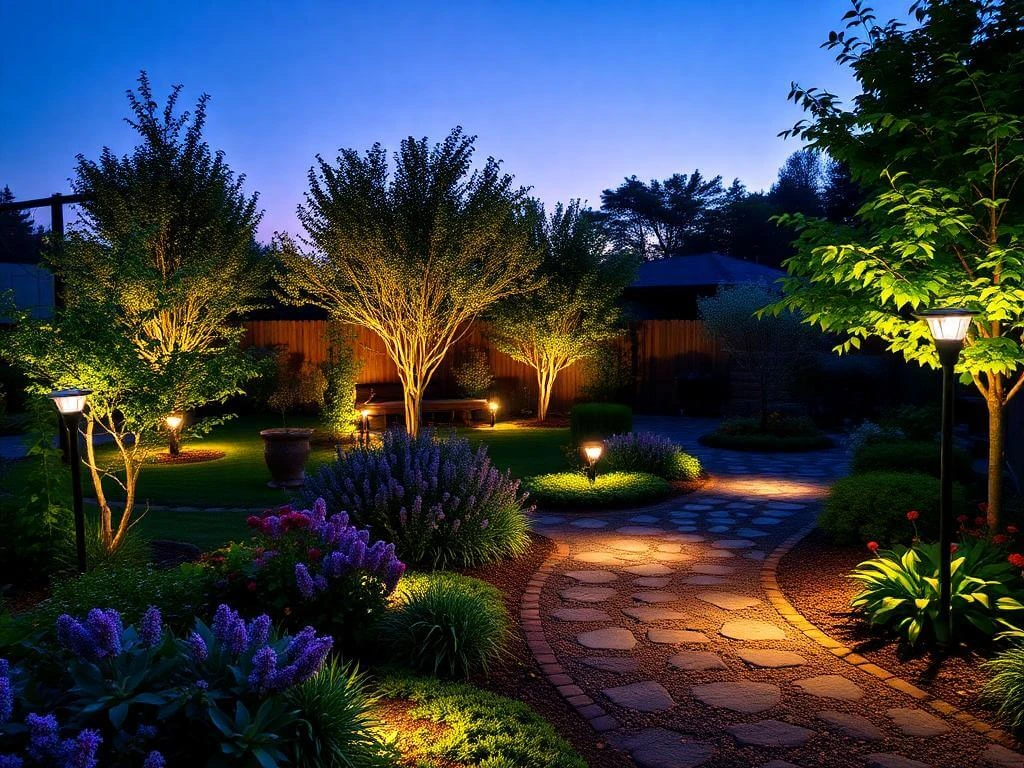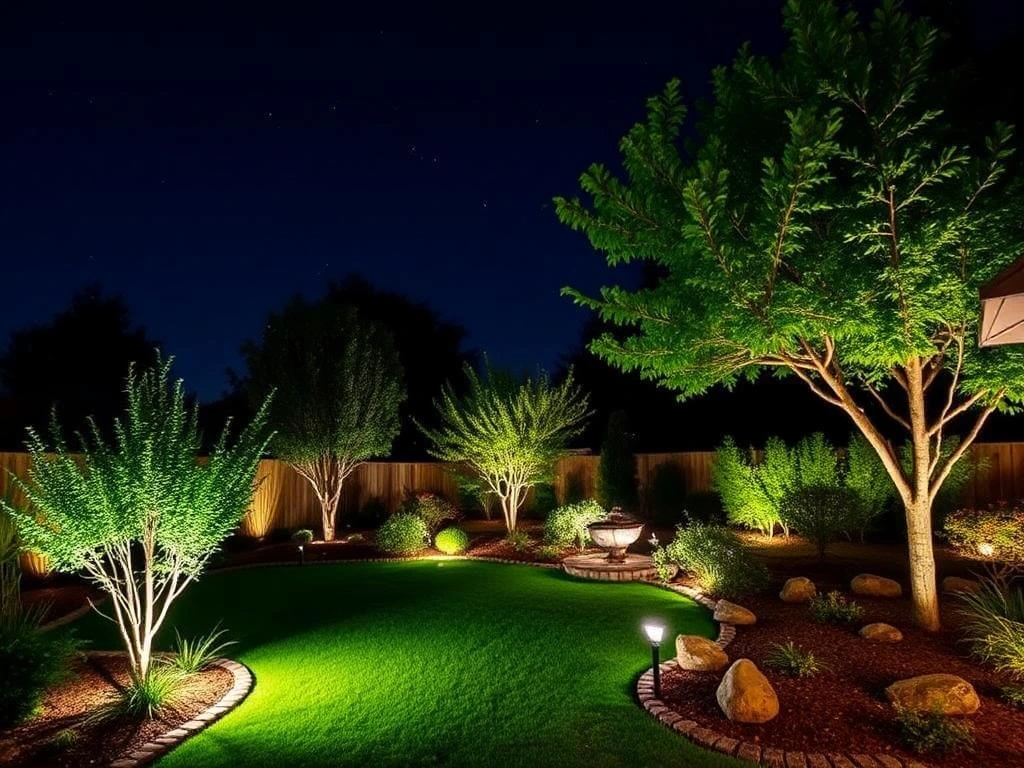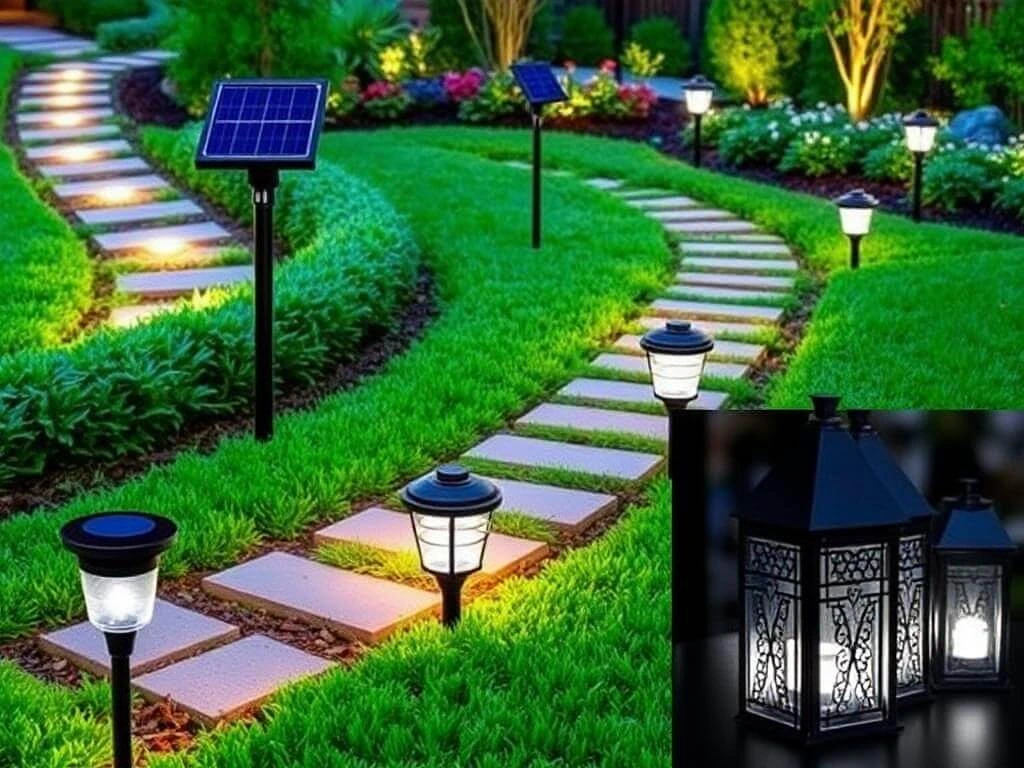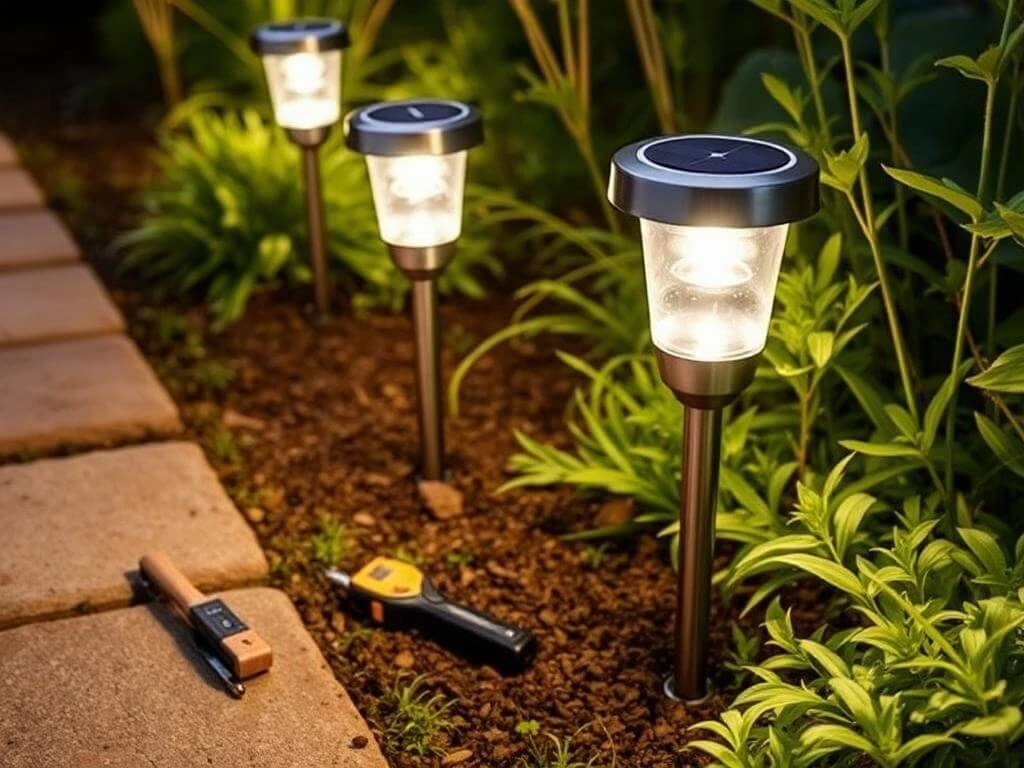Solar landscape lighting is a game-changer for illuminating outdoor spaces while staying eco-friendly and cost-effective. These innovative lights harness sunlight during the day and transform it into a soft, inviting glow for your garden, pathways, or patio at night. Whether you’re looking to enhance your yard’s aesthetics, boost security, or reduce energy costs, solar landscape lighting offers a sustainable solution that’s easy to install and maintain. In this FAQ guide, we’ll explore everything you need to know—from choosing the right solar lights to maximizing their performance—helping you effortlessly create a beautifully lit outdoor space.

1. What is Solar Landscape Lighting?
Solar landscape lighting refers to an eco-friendly and innovative way to illuminate outdoor spaces using solar-powered lights. These lights are designed to capture sunlight during the day and convert it into energy, which powers LED bulbs to light up your garden, pathways, or patio at night. With no need for wiring or electricity, solar landscape lighting offers a hassle-free and cost-effective solution for enhancing the beauty and functionality of your outdoor areas.
a. Key Components of Solar Landscape Lighting
Solar landscape lighting systems consist of several essential components:
- Solar Panels: These are the heart of the system, responsible for collecting sunlight and converting it into electrical energy. Most solar lights use photovoltaic (PV) panels to store energy efficiently.
- LED Bulbs: Known for their energy efficiency and long lifespan, LED bulbs are used to provide bright, reliable illumination.
- Rechargeable Batteries: These store the energy collected by the solar panels and release it to power the lights after dark.
b. How Solar Landscape Lighting Works
The functionality of solar landscape lighting is straightforward yet highly efficient:
- During the day, the solar panels absorb sunlight and convert it into electricity.
- This energy is stored in the rechargeable batteries within the light.
- At dusk, a built-in sensor detects the reduction in natural light and automatically switches on the LEDs, using the stored energy.
- At dawn, the lights turn off, and the cycle begins again.
c. Types of Solar Landscape Lighting
Solar landscape lighting is versatile and comes in various forms to suit different outdoor needs:
- Pathway Lights: Perfect for illuminating walkways, driveways, and garden paths.
- Spotlights: Ideal for highlighting specific features like trees, sculptures, or architectural details.
- Floodlights: Provide broad, intense light for larger areas such as patios or backyards.
- Decorative Lights: Include string lights, lanterns, and ornamental designs that add a whimsical or festive touch to outdoor spaces.
By understanding what solar landscape lighting is and how it works, you can make informed decisions about incorporating these sustainable lighting solutions into your outdoor design. This not only enhances your home’s curb appeal but also aligns with a greener, more energy-efficient lifestyle.

2. Benefits of Using Solar Landscape Lighting
Solar landscape lighting offers a wide range of advantages that make it an ideal choice for homeowners looking to illuminate their outdoor spaces sustainably and efficiently. From reducing energy costs to enhancing the beauty of your yard, these lights combine functionality, eco-friendliness, and aesthetics. Below are some of the key benefits of using solar landscape lighting in your outdoor design.
a. Eco-Friendly and Sustainable Outdoor Lighting
Solar landscape lighting relies on renewable energy from the sun, making it an environmentally friendly choice. By using solar power, you reduce your carbon footprint and eliminate the need for electricity generated by fossil fuels. This aligns with global efforts to embrace green energy solutions and protect the planet.
b. Cost Savings on Electricity Bills
One of the most appealing benefits of solar landscape lighting is its ability to save money. Since these lights are powered entirely by solar energy, they do not contribute to your monthly electricity bill. Over time, the savings on energy costs can outweigh the initial investment in high-quality solar lights, making them a cost-effective option.
c. Easy Installation and Low Maintenance
Unlike traditional lighting systems, solar landscape lighting requires no complicated wiring or electrical connections. Most solar lights are designed for quick and hassle-free installation, allowing homeowners to set them up without professional assistance. Additionally, they require minimal maintenance—occasional cleaning of the solar panels and checking the rechargeable batteries are usually sufficient to keep them functioning optimally.
d. Enhanced Curb Appeal and Aesthetic Value
Solar landscape lighting not only provides practical illumination but also enhances the visual appeal of your outdoor areas. Whether it’s highlighting garden features, illuminating pathways, or creating a warm ambiance, these lights add charm and elegance to your landscape. Decorative options, such as solar string lights or lanterns, can further personalize your outdoor spaces.
e. Reliable Performance in Various Conditions
Modern solar landscape lighting is designed to withstand diverse weather conditions, including rain, snow, and extreme temperatures. Many options are built with durable materials and come with features like waterproofing and UV resistance, ensuring reliable performance year-round.
f. Improved Safety and Security
By lighting up pathways, driveways, and entryways, solar landscape lighting reduces the risk of trips and falls in dimly lit areas. Additionally, strategically placed solar floodlights or spotlights can deter trespassers, improving the overall security of your home.
c. Flexibility and Portability
Solar lights are incredibly versatile and can be easily repositioned as needed. Whether you’re redesigning your garden or hosting an outdoor event, these portable lights can adapt to your changing needs without the hassle of rewiring.
Incorporating solar landscape lighting into your outdoor spaces not only saves energy and money but also elevates the aesthetic and functional appeal of your home. By choosing these eco-friendly lighting solutions, you make a sustainable investment that benefits both your household and the environment.

3. How to Choose the Right Solar Landscape Lighting
Selecting the right solar landscape lighting can transform your outdoor space, enhancing its beauty, functionality, and safety. With various styles, features, and price points available, it’s essential to consider your specific needs and preferences to make an informed decision. Here’s a guide to help you choose the perfect solar landscape lighting for your home.
a. Assess Your Outdoor Space and Lighting Needs
- Identify the Purpose: Determine why you need solar landscape lighting. Are you lighting up a pathway, showcasing a garden feature, or enhancing overall ambiance?
- Evaluate the Area: Measure the size of the space you want to illuminate and consider any obstacles like trees or structures that might block sunlight.
- Consider Placement: Ensure the locations you choose receive adequate sunlight for optimal performance. Shady areas may require solar lights with high-efficiency panels or backup options.
b. Look for Key Features
- Brightness (Lumens): Different areas require varying levels of brightness. Pathways may need softer lights (10–30 lumens), while floodlights or spotlights require higher lumens (100+).
- Battery Capacity: Choose lights with long-lasting batteries to ensure they stay illuminated throughout the night. Lithium-ion batteries are often more efficient and durable.
- Weather Resistance: Opt for solar lights with waterproof ratings (IP65 or higher) and UV-resistant materials to withstand harsh weather conditions.
- Sensor Options: Consider lights with motion sensors or automatic on/off features for added convenience and energy efficiency.
c. Choose the Right Design and Style
- Pathway Lights: Ideal for lining walkways, driveways, or garden paths. These often come with sleek, understated designs.
- Spotlights and Floodlights: Use these to highlight specific features like trees, sculptures, or architectural elements.
- Decorative Lights: String lights, lanterns, or novelty designs can add personality and charm to outdoor spaces.
- Wall-Mounted Lights: Perfect for illuminating entryways, patios, or fences.
d. Set a Budget
- Affordable Options: Entry-level solar landscape lighting can be cost-effective while providing basic functionality.
- Premium Choices: High-end models may include advanced features like adjustable brightness, larger solar panels, or extended warranties, offering better performance and durability.
- Long-Term Savings: Remember that investing in quality solar lights may save you money in the long run through reduced maintenance and energy costs.
e. Check Reviews and Recommendations
Before making a purchase, research reviews and recommendations from other homeowners. Look for feedback on brightness, durability, and overall performance to ensure the lights meet your expectations.
f. Match the Lighting to Your Landscape Theme
Consider how the style and color temperature of the solar lights will complement your outdoor design. Warm white lights create a cozy ambiance, while cool white lights are more modern and functional.
By carefully evaluating your needs and the features of available products, you can select solar landscape lighting that perfectly aligns with your outdoor space, aesthetic preferences, and budget. A well-chosen lighting system will not only enhance your yard’s visual appeal but also provide practical and sustainable illumination for years to come.

4. Installation and Maintenance Tips for Solar Landscape Lighting
Proper installation and maintenance of solar landscape lighting are essential to ensure its optimal performance and longevity. By following best practices, you can maximize the efficiency of your solar lights and keep your outdoor spaces beautifully illuminated year-round. Below are expert tips for installing and maintaining solar landscape lighting.
a. Best Placement for Maximum Sunlight Exposure
- Choose Sunny Locations: Position solar lights in areas that receive direct sunlight for at least 6–8 hours a day. Avoid placing them under dense foliage, shaded spots, or near structures that block sunlight.
- Angle the Solar Panel Correctly: Ensure that the solar panel is angled toward the sun to capture maximum energy during the day. Some solar lights come with adjustable panels for flexibility.
- Consider Seasonal Changes: Be mindful of how sunlight shifts with the seasons and adjust the placement if necessary to maintain efficiency.
b. Ensuring Proper Spacing and Alignment
- Even Illumination: Space your solar landscape lights evenly to achieve balanced lighting across pathways, gardens, or patios. Avoid clustering lights too closely, as it may create uneven brightness.
- Highlight Key Features: Use spotlights or floodlights to accentuate focal points such as trees, statues, or water features, ensuring they are positioned at the right distance for optimal effect.
- Safe Placement: Install lights in areas where they won’t be easily tripped over or damaged by foot traffic, pets, or lawn equipment.
c. Cleaning and Maintaining Solar Panels
- Regular Cleaning: Dust, dirt, and debris can accumulate on solar panels, reducing their efficiency. Clean the panels with a soft cloth and mild soap solution every few weeks.
- Check for Obstructions: Remove any leaves, branches, or snow that may obstruct sunlight from reaching the solar panels.
- Inspect for Damage: Periodically inspect the lights for cracks, loose connections, or signs of wear and tear. Replace damaged parts promptly.
d. Ensuring Long Battery Life
- Rechargeable Battery Care: Most solar landscape lighting uses rechargeable batteries, which can last 1–3 years. Replace them as needed to maintain consistent lighting performance.
- Storage During Winter: If you live in an area with harsh winters, consider storing your solar lights indoors to protect the batteries and panels from extreme cold and snow.
e. Troubleshooting Common Issues
- Dim or Flickering Lights: Clean the solar panel and ensure it is receiving adequate sunlight. Check if the batteries need replacement.
- Lights Not Turning On: Inspect the on/off switch, if available, and ensure it’s set to the correct mode. Confirm that the solar panel is not obstructed and the battery is functional.
- Reduced Runtime: Over time, the battery may degrade, resulting in shorter runtimes. Replacing the battery can often resolve this issue.
f. Optimize Longevity and Performance
- Avoid Harsh Chemicals: When cleaning the lights, avoid using abrasive materials or harsh chemicals that could damage the panels or casings.
- Protect from Extreme Weather: For areas prone to heavy rain or snow, choose solar landscape lighting with high waterproof ratings (IP65 or above) and durable materials.
- Perform Seasonal Checks: Conduct a thorough inspection and cleaning at the start of each season to ensure your lights are ready to perform optimally.
By following these installation and maintenance tips, you can extend the lifespan of your solar landscape lighting and enjoy a consistently bright, energy-efficient outdoor space. Proper care not only enhances the performance of your lights but also ensures they remain an attractive and sustainable feature of your home’s exterior.

5. Frequently Asked Questions About Solar Landscape Lighting
Solar landscape lighting is a popular choice for homeowners looking to enhance their outdoor spaces with sustainable and cost-effective illumination. Below are some of the most frequently asked questions about solar landscape lighting, providing clarity and insights to help you make the most of this innovative lighting solution.
a. How Does Solar Landscape Lighting Work?
Solar landscape lighting operates by converting sunlight into electricity using photovoltaic (solar) panels. During the day, the panels collect solar energy and store it in rechargeable batteries. At night, this stored energy powers the LED lights, providing illumination without the need for traditional electricity. The entire process is automated, with many lights featuring sensors that turn them on at dusk and off at dawn.
b. Do Solar Landscape Lights Work in Cloudy Weather or Winter?
Yes, solar landscape lighting can still function in cloudy weather or during winter months, although their efficiency may decrease. Even on overcast days, solar panels can capture some sunlight, but the lights may not be as bright or last as long at night. Choosing high-quality solar lights with efficient panels and batteries can help mitigate this issue.
c. What Are the Best Locations for Installing Solar Landscape Lighting?
The best locations for solar landscape lighting are areas that receive direct sunlight for 6–8 hours a day. Pathways, gardens, and driveways often make ideal spots. Ensure the solar panels are free from obstructions like trees, shrubs, or structures that could block sunlight. If you have shaded areas, consider solar lights with separate, adjustable panels that can be placed in sunnier spots.
d. How Long Do Solar Landscape Lights Last?
The lifespan of solar landscape lighting varies depending on the quality of the product and how well it is maintained. On average:
- LED Lights: Last 10–15 years.
- Batteries: Need replacement every 1–3 years.
- Solar Panels: Can last up to 20 years with proper care.
Regular maintenance, such as cleaning panels and replacing batteries, can extend the life of your solar lights.
e. Are Solar Landscape Lights Bright Enough for Security Purposes?
Yes, solar landscape lighting can be used for security purposes, but you’ll need lights with higher lumen output, such as solar floodlights or spotlights. These are designed to provide brighter illumination and often come with motion sensors, which enhance their effectiveness in deterring intruders.
f. Can Solar Landscape Lights Be Left Outside Year-Round?
Most high-quality solar landscape lights are designed to withstand various weather conditions and can be left outside year-round. Look for lights with weather-resistant features, such as waterproof casings (IP65 or higher) and UV-resistant materials. In areas with harsh winters, you may want to store the lights indoors to protect them from extreme cold and snow.
g. Do I Need Professional Help to Install Solar Landscape Lighting?
No, solar landscape lighting is generally easy to install and does not require professional help. Most models are designed for DIY installation and come with simple instructions. You only need to ensure the solar panels are positioned to receive adequate sunlight. However, if you’re installing a more complex system, such as solar-powered security lights, you might consider professional assistance.
h. Are Solar Landscape Lights Expensive?
Solar landscape lighting is available at various price points to suit different budgets. While the upfront cost of high-quality solar lights may be higher, they save money in the long run by eliminating electricity costs and requiring minimal maintenance. Additionally, they are a one-time investment that contributes to energy savings over time.
i. Can Solar Landscape Lighting Be Used for Large Outdoor Areas?
Yes, solar landscape lighting can effectively illuminate large outdoor areas by strategically placing multiple lights. Options like solar spotlights, floodlights, and string lights can be combined to create a cohesive lighting design that covers larger spaces. Ensure you choose lights with sufficient brightness and battery capacity for extended coverage.
j. How Can I Troubleshoot Issues With My Solar Landscape Lights?
If your solar landscape lights aren’t functioning properly:
- Check the Solar Panel: Ensure it’s clean and free of obstructions.
- Inspect the Battery: Replace the rechargeable battery if it’s not holding a charge.
- Verify Placement: Ensure the lights are positioned in a sunny area.
- Switch Settings: Confirm that the on/off switch is in the correct position.
Most issues can be resolved with basic troubleshooting, but for persistent problems, refer to the manufacturer’s guide.
By addressing these common questions, you can better understand solar landscape lighting and make the most of its benefits. Whether you’re considering installation or looking to optimize your current setup, this FAQ provides valuable insights to guide your choices.

Conclusion
Solar landscape lighting is an excellent, sustainable solution to enhance the beauty, security, and functionality of your outdoor spaces. From improving your garden’s aesthetics to providing effective illumination along pathways and driveways, solar lights offer versatility and energy efficiency. By choosing the right lights, installing them in optimal locations, and performing regular maintenance, you can enjoy long-lasting and cost-effective lighting for years to come.
Understanding the benefits, installation tips, and frequently asked questions will help you make informed decisions about solar landscape lighting, ensuring you get the most out of your investment. Whether you’re lighting up a small garden or illuminating a large yard, solar landscape lighting can transform your outdoor environment, providing both practical and visual appeal. Embrace the power of the sun and create a beautiful, eco-friendly lighting solution for your home today!
